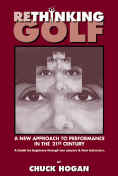Rethinking Golf
Not all golfers will like this book.
That’s okay with Chuck Hogan, the PGA professional who wrote it.
Hogan is trying to reach beyond the mindset of those who think about golf in terms of “how-to”, and connect instead with those who don’t mind remembering what it means to “play” golf.
For Hogan, much of what passes for effective golf instruction is too centered upon process issues such as the backswing, when the real purpose should be to help golfers understand what they want out of the game, and then helping them find it.
He’s not big on most of the instruction books, because they place too much emphasis on the technicalities. Based on the number of references made to it, Hogan’s favorite golf book is Harvey Penick’s Little Red Book.
He has a point, at least from my personal perspective. I have now read so many how-to books for these reviews that I’m sure my mind is on overload nearly every time I step onto a tee box.
I know I should clear out my thoughts and just adopt the Bruce Lietzke attitude Hogan recommends: know your swing and play to it.
Easier said than done, sometimes.
Several years ago I overheard someone ask our club’s pro at the time how he hit a draw. The pro said, “As I get over the ball, I just think draw, and then I do it.” Hogan repeats the same answer in this book, this time coming from a touring pro, and recognizes that this response is bound to frustrate those who want a detailed, A-to-B-to-C description. On the other hand, it is precisely the answer Hogan believes should be given more often.
Hogan reminds us that too many golfers leave their regular jobs go to the range, and then “work” on their game. Where’s the play in that process? How about a little less thinking and a little more remembering a child’s sense of fun?
It’s not as if the fundamentals can be ignored. Hogan recognizes that fact, but suggests that the focus on the swing ignores the true fundamental of the game, which is to hit a round ball with a flat edge and make it move toward a target.
One of the teaching/learning images to which Hogan refers really struck home with me. He argues that learning the fundamentals of set-up, grip, stance, alignment, basic full swing, chipping, sand shots, and putting should be accomplished in much the same way as learning to type.
In typing class, the elements can be broken down and accomplished by direct physical repetition for each phase. As that segment becomes rote, the budding typist can then move on to the next segment. Eventually, the entire process of typing becomes simply a background tool on which the real work of creation (writing) takes place.
Similarly, the basic elements of the swing can be learned in segments by repetition, until the player develops competence by rote. At that point, the real work of creation in in golf takes place, by shifting one’s entire focus on the target, imagining the shot and distance to reach the target, and then unconsciously adjusting the rote swing to the goal.
I do this in my putting, which is the best part of my game. It would help if I could remember this on other parts of the golf course.
One segment of the book is aimed directly at golf instructors. It looks like it would be very useful for the pros, even if they don’t necessarily agree with Hogan. Among other things, the chapter includes a questionnaire that Hogan uses in his own classes.
I know that if my pro asked these questions, I would more readily accept his instructions, because the form shows me that he interested in tailoring his teaching to my needs and wants. That’s not only good marketing, but also a sign of true professionalism.
On occasion, the editor in me wanted to fix parts of this book. There’s the occasional misspelling and misused word or two. Still, there’s no doubting the depth of Hogan’s commitment to his beliefs, and if one owns the book, it’s okay to make the correction in the text, even in ink.
I’m going to go play golf now. Thanks, Chuck, for reminding me.
Review Date: June 29, 2002


